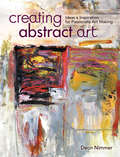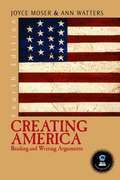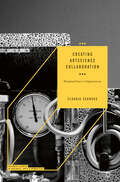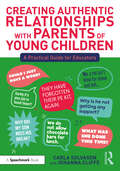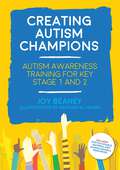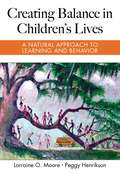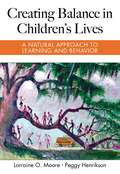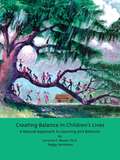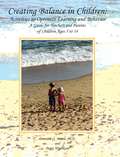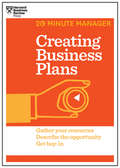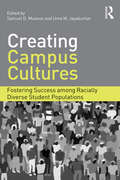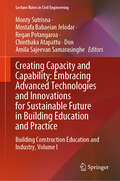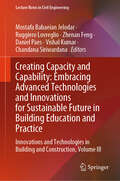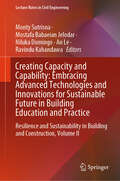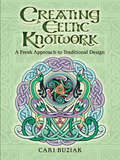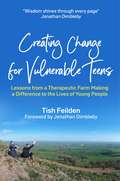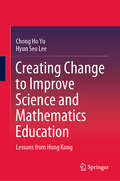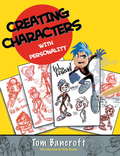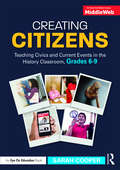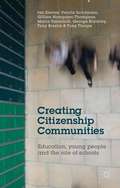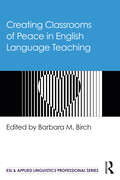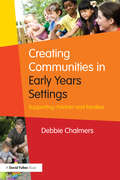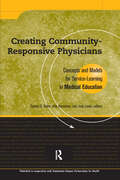- Table View
- List View
Creating Abstract Art: Ideas and Inspirations for Passionate Art-Making
by Dean NimmerCelebrate your own nonconformist place in the world of art. Going far beyond standard notions of developing an abstract "style" or particular "look," Creating Abstract Art unleashes the numerous possibilities that abound in your creative subconscious. Familiar obstacles such as "I don't know what to paint" or "How do I know if this is good?" are easily set aside as you explore fun exercises such as connecting dots, automatic drawing, shadow hunting, working with haiku poetry paintings and much more. So turn off the noise in your head, follow your own instincts and delight in what emerges! 40 exercises exploring original ideas and inventive techniques for making abstract art. Projects can be done in any order and with nearly any materials--start working right away on any project that grabs your attention! 50 contemporary artists share diverse work and viewpoints on the process of working abstractly. Write your own artistic license and start Creating Abstract Art your way, today!
Creating America: Reading and Writing Arguments (Fourth Edition)
by Joyce Moser Ann WattersThematic argument reader with rhetoric (writing guide) on arguments presents selections and images that depict the political and social changes in America from the Revolutionary War to the twenty-first century. Its argumentative focus will teach readers how to persuade others through written words and visual ideas. High Interest topics including 27 new essays, 4 films, and 10 advertisements/pieces of art; information on visual arguments and online research; an in-depth examination of one country's culture within a range of cultures over time. For persuasive writers.
Creating ArtScience Collaboration: Bringing Value to Organizations (Palgrave Studies in Business, Arts and Humanities)
by Claudia SchnuggHow can artist-scientist collaboration be of value to science and technology organizations? This innovative book is one of the first to address this question and the emerging field of art-science collaboration through an organizational and managerial lens. With extensive experience collaborating with and advising institutions to develop artist in residency programs, the author highlights how art-science collaboration is such a powerful opportunity for forward-thinking consultants, managers and institutions. Using real-life examples alongside cutting edge research, this book presents a number of cases where these interactions have fostered creativity and led to heightened innovation and value for organizations. As well as creating a blueprint for successful partnerships it provides insights into the managerial and practical issues when creating art-science programs. Invaluable to scholars and practitioners interested in the potential of art-science collaboration, the reader will be shown how to take an innovative approach to creativity in their organization or research, and the ways in which art-science collaborations can mutually benefit artists, scientists and companies alike.
Creating Authentic Relationships with Parents of Young Children: A Practical Guide for Educators
by Carla Solvason Johanna CliffeDealing with parents can be scary and intimidating, especially when you are relatively new to your role, but it can also be hugely rewarding. What do you need to know? Which barriers are you likely to face? Most importantly, how can you nurture a positive and authentic relationship with parents and carers where you genuinely work together for the best interests of the child? Written by authors who have experienced being on both sides of the fence, as educators and as parents, this practical book takes a frank approach to recognising the turbulent world of parenting and shines a light on issues that are, all too often, dismissed. It considers the pragmatic, kind, and caring ways that educational settings can support parents’ struggles, as well as benefitting from their wide-ranging knowledge and capabilities. With activities and reflections included throughout, the book invites the reader to consider their practice, and to look at their relationships with parents with fresh eyes, all whilst keeping the child in mind. With a focus on celebrating the value of truly listening and forming authentic relationships, this book will be essential reading for early years’ educators, childminders, primary teachers, TAs, and SENCOs.
Creating Autism Champions: Autism Awareness Training for Key Stage 1 and 2
by Haitham Al-Ghani Joy BeaneyRaising awareness and understanding of autism has school-wide benefits, such as helping to improve the attitudes of pupils and staff and allowing children with autism to thrive socially, emotionally and educationally alongside their peers. This comprehensive resource provides a whole school programme for raising autism awareness and promoting inclusion. It includes training for staff in the knowledge and skills they need to support pupils, a sample school assembly, and lesson plans for teaching groups of pupils to be 'autism champions'. This programme also offers photocopiable worksheets and online presentations to use as part of the staff training, school assembly and peer awareness lessons. There is advice for involving children with autism and their parents in school activities. Easily adaptable for different age groups, this is a ready-made resource for schools committed to promoting autism awareness and whole school welfare.
Creating Balance in Children's Lives: A Natural Approach to Learning and Behavior
by Lorraine MooreThrough the 1990s and into the present, concerns have increased regarding children's learning, behavior and health. In this book, educators, parents, and childcare providers will find options for addressing these concerns. The strategies presented will help balance and optimize children's physical, mental, emotional, and social development. Look inside to learn more about; the many aspects of balance; how the body, mind, and heart work together; how emotions affect learning and behavior; the importance of nutrition; meeting children's basic needs; how to recognize symptoms and sources of imbalance; options for preventing and correcting imbalances. Children are the world's most precious resources. A cooperative effort on the part of adults in behalf of all children is urgently needed to set the course for our future. This book can be a guide for this important process.
Creating Balance in Children's Lives: A Natural Approach to Learning and Behavior
by Lorraine MooreThrough the 1990s and into the present, concerns have increased regarding children's learning, behavior and health. In this book, educators, parents, and childcare providers will find options for addressing these concerns. The strategies presented will help balance and optimize children's physical, mental, emotional, and social development. Look inside to learn more about; the many aspects of balance; how the body, mind, and heart work together; how emotions affect learning and behavior; the importance of nutrition; meeting children's basic needs; how to recognize symptoms and sources of imbalance; options for preventing and correcting imbalances. Children are the world's most precious resources. A cooperative effort on the part of adults in behalf of all children is urgently needed to set the course for our future. This book can be a guide for this important process.
Creating Balance in Children's Lives: A Natural Approach to Learning and Behavior
by Peggy Henrikson Lorraine O. MooreFormerly published by Peytral PublicationsEducators will discover how emotions affect learning and behavior, recognize the symptoms and sources of imbalance, and promote students' physical, mental, emotional, and social development.
Creating Balance in Children: A Guide for Teachers and Parents of Children Ages 5 to 14
by Lorraine O. MooreEducate the whole child with over one hundred activities that promote physical, cognitive, and emotional/social balance in children!This insightful resource helps educators, parents, and childcare providers discover how emotions affect learning and behavior, recognize the symptoms and sources of imbalance, and promote students' physical, mental, emotional, and social development. Students and teachers will learn more about the body-mind-heart connection, the importance of nutrition, and options for correcting and preventing imbalance with over one-hundred activities.Using the author's flexible guidelines, teachers can help children develop attributes such as kindness and courage, love and joy, and a sense of meaning and interconnectedness. Creating Balance in Children: Activities to Optimize Learning and Behavior takes the lessons learned from Creating Balance in Children’s Lives and transforms them into easy-to-use activities for use in the home and the classroom.
Creating Business Plans
by Harvard Business ReviewA well-crafted business plan generates enthusiasm for your idea and boosts your odds of success-whether you're proposing a new initiative within your organization or starting an entirely new company. Creating Business Plans quickly walks you through the basics. You'll learn to: Present your idea clearly Develop sound financial plans Project risks-and rewards Anticipate and address your audience's concernsAbout HBR's 20-Minute Manager Series:Don't have much time? Get up to speed fast on the most essential business skills with HBR's 20-Minute Manager series. Whether you need a crash course or a brief refresher, each book in the series is a concise, practical primer that will help you brush up on a key management topic.Advice you can quickly read and apply, for ambitious professionals and aspiring executives-from the most trusted source in business. Also available as an ebook.
Creating Campus Cultures: Fostering Success among Racially Diverse Student Populations
by Samuel D. Museus Uma M. JayakumarMany colleges and universities have not engaged in the critical self-examination of their campuses necessary for effectively serving racially diverse student populations. This timely edited collection provides insights into how campus cultures can and do shape the experiences and outcomes of their increasingly diverse college student populations. By cultivating values, beliefs, and assumptions that focus on including, validating, and creating equitable outcomes among diverse undergraduate students, an institution can foster their success.While attention to campus climate is critical for gauging the nature of an institution’s culture and how students are experiencing the campus environment, changes in climate alone will not lead to holistic and deep rooted institutional transformation. Moving beyond previous explorations of campus racial climates, Creating Campus Cultures addresses the considerable institutionally embedded obstacles practitioners face as they attempt to transform entrenched institutional cultures to meet the needs of diverse student bodies. A broad range of chapters include voices of students, new research, practical experiences, and application of frameworks that are conducive to success. This book will help student affairs and higher education administrators navigate this increasingly difficult terrain by providing practical advice on how to foster success among racial minority students and enact long-term, holistic change at any institution.
Creating Capacity and Capability: Building Construction Education and Industry, Volume I (Lecture Notes in Civil Engineering #562)
by Regan Potangaroa Monty Sutrisna Mostafa Babaeian Jelodar Chinthaka Atapattu Don Amila Sajeevan SamarasingheThis three-volume book is the proceeding of the 46th Australasian Universities Building Education Association (AUBEA) 2023 Conference which brings together papers on construction and built environment education and practice. This particular conference theme, “Creating Capacity and Capability: Embracing Technologies and Innovations for Sustainable Future in Building Education and Practice” is closely related to a flagship national research programme funded by the Government of New Zealand, known as the CanConstructNZ research programme, aiming to balance the capacity and capability in the construction industry and the national pipeline of construction projects. The capacity and capability of our construction industry in fulfilling the construction needs of the whole nation are reflected in the national pipeline of construction projects and have long been recognised as one of the main challenges facing the construction sector. The practices and education of building and construction play an important role in determining the capacity and capability of the construction industry. Within the context of achieving sustainable future and embracing advanced technologies to create capacity and capability in the construction sector, various concepts, research, and innovative development have emerged and taken place. This particular conference theme has facilitated more in-depth discourses and discussions on the latest ideas and innovation within the building and construction education and practice, not only from the Australasian region but also from the wider international community, including the USA, the UK, Brazil, South Africa, Nigeria, China, and Sri Lanka. The contents of this book will be of interest to academic researchers, industry professionals and policy makers alike.
Creating Capacity and Capability: Innovations and Technologies in Building and Construction, Volume III (Lecture Notes in Civil Engineering #564)
by Vishal Kumar Mostafa Babaeian Jelodar Ruggiero Lovreglio Zhenan Feng Daniel Paes Chandana SiriwardanaThis three-volume book is the proceeding of the 46th Australasian Universities Building Education Association (AUBEA) 2023 Conference which brings together papers on construction and built environment education and practice. This particular conference theme, &“Creating Capacity and Capability: Embracing Advanced Technologies and Innovations for Sustainable Future in Building Education and Practice&” is closely related to a flagship national research programme funded by the Government of New Zealand, known as the CanConstructNZ research programme, aiming to balance the capacity and capability in the construction industry and the national pipeline of construction projects. The capacity and capability of our construction industry in fulfilling the construction needs of the whole nation are reflected in the national pipeline of construction projects and have long been recognised as one of the main challenges facing the construction sector. The practices and education of building and construction play an important role in determining the capacity and capability of the construction industry. Within the context of achieving sustainable future and embracing advanced technologies to create capacity and capability in the construction sector, various concepts, research, and innovative development have emerged and taken place. This particular conference theme has facilitated more in-depth discourses and discussions on the latest ideas and innovation within the building and construction education and practice, not only from the Australasian region but also from the wider international community, including the USA, the UK, Brazil, South Africa, Nigeria, China, and Sri Lanka. The contents of this book will be of interest to academic researchers, industry professionals and policy makers alike.
Creating Capacity and Capability: Resilience and Sustainability in Building and Construction, Volume II (Lecture Notes in Civil Engineering #563)
by Monty Sutrisna Ravindu Kahandawa Mostafa Babaeian Jelodar Niluka Domingo An LeThis three-volume book is the proceeding of the 46th Australasian Universities Building Education Association (AUBEA) 2023 Conference which brings together papers on construction and built environment education and practice. This particular conference theme, &“Creating Capacity and Capability: Embracing Advanced Technologies and Innovations for Sustainable Future in Building Education and Practice&” is closely related to a flagship national research programme funded by the Government of New Zealand, known as the CanConstructNZ research programme, aiming to balance the capacity and capability in the construction industry and the national pipeline of construction projects. The capacity and capability of our construction industry in fulfilling the construction needs of the whole nation are reflected in the national pipeline of construction projects and have long been recognised as one of the main challenges facing the construction sector. The practices and education of building and construction play an important role in determining the capacity and capability of the construction industry. Within the context of achieving sustainable future and embracing advanced technologies to create capacity and capability in the construction sector, various concepts, research, and innovative development have emerged and taken place. This particular conference theme has facilitated more in-depth discourses and discussions on the latest ideas and innovation within the building and construction education and practice, not only from the Australasian region but also from the wider international community, including the USA, the UK, Brazil, South Africa, Nigeria, China, and Sri Lanka. The contents of this book will be of interest to academic researchers, industry professionals and policy makers alike.
Creating Capacity for Learning and Equity in Schools: Instructional, Adaptive, and Transformational Leadership
by Victoria L. Bernhardt Mary A. HooperSuccessful educational leaders develop people, processes, culture, and structures in their schools. Creating Capacity for Learning and Equity in Schools provides a comprehensive guide for aspiring and practicing leaders to strengthen their capacity to create high levels of learning and equity. Chapters explore key theories and research, provide resources for developing personal and organizational leadership capacity, and guide leaders through a reflective process to help them link theory and practice. Hooper and Bernhardt's model for excellence and equity provides a pathway for educators to create and sustain learning communities in schools. Exploring three leadership approaches--Instructional, Adaptive, and Transformational--this textbook prepares and develops leaders to engage school communities through effective instructional leadership, data-informed decision-making, and a vision for learning and equity for all. Special Features: Theory to Practice (T2P) Framework--A series of structured exercises help readers review and reflect on existing organizational practices and develop new action plans. Case Studies--Encourage individual reflection and collective discussion on key leadership scenarios. Examples in Action--Challenge readers to analyze new connections and leadership processes. A companion website--Includes additional resources and tools for instructors to facilitate activities in the classroom.
Creating Celtic Knotwork: A Fresh Approach to Traditional Design (Dover Art Instruction)
by Cari BuziakWhether you're a complete beginner or have already attempted to learn the art of Celtic knotwork, this is the book for you! Artists at all levels will treasure this guide, which not only demonstrates how to duplicate patterns from a rich and varied gallery of examples but also how to take the next step to creating your own unique designs.This newly revised edition of Creating Celtic Knotwork features a wealth of added material and revisions. Author Cari Buziak draws upon her extensive teaching experience to present easy-to-understand, well-illustrated instructions that explain all the basic techniques of Celtic patterns as well as the art's meaning and history. In addition to spirals, mazes, and step patterns, the designs include dragons, hounds, and other animals as well as human forms. Exercises and tips encourage experimentation that will allow you to develop your own variations on traditional forms. Information on drawing tools, painting materials, transferring patterns, and other practical aspects will help you get started right away.
Creating Change for Vulnerable Teens: Lessons from a Therapeutic Farm Making a Difference to the Lives of Young People
by Tish FeildenCreating Change for Vulnerable Teens tells the story of Tish Feilden and Jamie's Farm - a network of therapeutic farms dedicated to transforming the lives of disadvantaged children.Documenting Tish's experiences of working with truly remarkable teens who have faced huge challenges in their lives, the book describes how the farms help young people to thrive academically, socially and emotionally. She shares the approaches they have pioneered, including the critical importance of trust, of looking behind the behaviour and of really connecting with the desires and hopes of young people. If you have an interest in supporting vulnerable children or young people, this book provides a wealth of inspiration and ideas you can use, whatever the setting.
Creating Change to Improve Science and Mathematics Education: Lessons from Hong Kong (Springerbriefs In Education Ser.)
by Chong Ho Yu Hyun Seo LeeThis book discusses the merits and potential shortcomings of Hong Kong STEM education from Grade 8 to Grade 12. Based on concurrent triangulated mixed-method methodology, which integrates both quantitative and qualitative procedures, it describes various change models and proposes new models that are considered compatible with Western cultures.
Creating Characters with Personality
by Glen Keane Tom BancroftFrom Snow White to Shrek, from Fred Flintstone to SpongeBob SquarePants, the design of a character conveys personality before a single word of dialogue is spoken. Designing Characters with Personality shows artists how to create a distinctive character, then place that character in context within a script, establish hierarchy, and maximize the impact of pose and expression. Practical exercises help readers put everything together to make their new characters sparkle. Lessons from the author, who designed the dragon Mushu (voiced by Eddie Murphy) in Disney's Mulan--plus big-name experts in film, TV, video games, and graphic novels--make a complex subject accessible to every artist.
Creating Citizens: Teaching Civics and Current Events in the History Classroom, Grades 6–9
by Sarah CooperEngage students in meaningful civic learning and encourage them to become active and informed citizens. With this essential book, co-published by Routledge and MiddleWeb, you will gain a variety of practical strategies for teaching civics and current events to your middle school students. Author and expert teacher Sarah Cooper takes you into her school and shares her classroom-tested methods and tools.Topics include: Fitting current events into an already-packed history curriculum Staying nonpartisan and fostering balanced discussions Helping students find their stake in the news Teaching civic literacy through primary sources, then and now Encouraging students to invest in analytical writing Fostering student ownership of our classrooms through discussion and debate Cultivating citizenship through empathy and community engagement Throughout the book, you’ll find student examples, handouts, and rubrics, so that you can easily implement the ideas in your own classroom. By getting your students to think critically about current events, you will help them become passionate writers, thinkers, and involved citizens.
Creating Citizenship Communities
by Tony Thorpe Ian Davies Vanita Sundaram Gillian Hampden-Thompson Maria Tsouroufli George Bramley Tony BreslinThis book addresses what is globally acknowledged to be one of the most fundamental and pressing concerns in contemporary society: the ways in which education can help young people understand - and play a full and active part - in contemporary society. On the basis of a national project funded by the Esmee Fairbairn Foundation and conducted as part of a partnership between the National Foundation of Educational Research and the Department of Education at the University of York, UK, the authors analyse data from young people and teachers to explore what they understand by citizenship and community and what they currently do, and would like to do, to promote more effective learning and engagement. On the basis of this research the authors make recommendations to enhance levels of understanding and opportunities for engagement in citizenship communities. "
Creating Classrooms of Peace in English Language Teaching (ESL & Applied Linguistics Professional Series)
by Barbara M. BirchTimely and accessible, this edited volume brings together leading scholars to discuss methods for supporting reconciliation, peace, and sustainable and social change in English language teaching. Around the world, peace and reconciliation are urgent themes that are inextricably connected to the study and practice of teaching English. The book features a diversity of voices and addresses pedagogies of peace, universal responsibility, and global interdependence in the domain of English language education. Organized in three strands, Part 1 addresses policy and implementation, Part 2 addresses teacher education, and Part 3 addresses content and lesson planning. With chapters drawn from a dozen countries and contexts, this book paves the way for English language teachers to harness their social capital and pedagogical agency to create sustainable peace globally and locally, and in and outside the classroom. It is essential reading for scholars and students in TESOL, applied linguistics, and peace education.
Creating Comics as Journalism, Memoir and Nonfiction
by Randy Duncan Michael Ray Taylor David StoddardThis book provides student journalists, artists, designers, creative writers and web producers with the tools and techniques they need to tell nonfiction stories visually and graphically. Weaving together history, theory, and practical advice, seasoned nonfiction comics professors and scholars Randy Duncan, Michael Ray Taylor and David Stoddard present a hands-on approach to teach readers from a range of backgrounds how to develop and create a graphic nonfiction story from start to finish. The book offers guidance on: -how to find stories and make use of appropriate facts and visuals; -nonfiction narrative techniques; -artist's tools and techniques; -print, digital, and multimedia production; -legal and ethical considerations. Interviews with well-known nonfiction comics creators and editors discuss best practices and offer readers inspiration to begin creating their own work, and exercises at the end of each chapter encourage students to hone their skills.
Creating Communities in Early Years Settings: Supporting children and families
by Debbie ChalmersCreating Communities in Early Years Settings encourages and supports all early years practitioners who work with children and their families within the Early Years Foundation Stage. Offering advice, ideas and strategies for developing an early learning community, this book provides clear guidance and real world examples that show how practitioners can provide an excellent, inclusive service to meet the needs of young children and their families and help them to thrive. Debbie Chalmers presents innovative and practical ideas to promote progress, development and inclusion, while outlining potential pitfalls and explaining how to identify and cater for individual needs. Chapters cover key topics such as: the legal responsibilities of a setting inclusion parental participation and parent managed settings roles and duties of different staff within a setting effective and sensitive communication with colleagues and caregivers and managing transitions. Creating Communities in Early Years Settings is designed to support early years practitioners, teachers, teaching assistants, nannies and childminders working with babies and children within the Early Years Foundation Stage. The book will also be of interest to students on early years childcare and education courses from level 2 upwards.
Creating Community-Responsive Physicians: Concepts and Models for Service-Learning in Medical Education
by Sarena D. Seifer, Kris Hermanns, Judy Lewis, Edward ZlotkowskiEighth in AAHE’s Service-Learning in the Disciplines Series, this volume shows how service-learning is not only a strategy for preparing community-responsive and competent health physicians, but also for fostering citizenship and changing the relationship between communities and medical schools. This very useful book provides readers with a valuable source of information and inspiration to develop and expand service-learning across the continuum of medical education.
